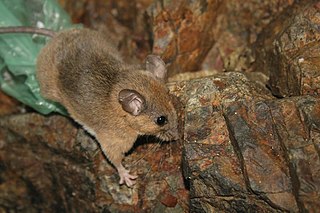
The harvest mouse is a small rodent native to Europe and Asia. It is typically found in fields of cereal crops, such as wheat and oats, in reed beds and in other tall ground vegetation, such as long grass and hedgerows. It has reddish-brown fur with white underparts and a naked, highly prehensile tail, which it uses for climbing. It is the smallest European rodent; an adult may weigh as little as 4 grams (0.14 oz). It eats chiefly seeds and insects, but also nectar and fruit. Breeding nests are spherical constructions carefully woven from grass and attached to stems well above the ground.

The Old World rats and mice, part of the subfamily Murinae in the family Muridae, comprise at least 519 species. Members of this subfamily are called murines. In terms of species richness, this subfamily is larger than all mammal families except the Cricetidae and Muridae, and is larger than all mammal orders except the bats and the remainder of the rodents.

The western harvest mouse is a small neotomine mouse native to most of the western United States. Many authorities consider the endangered salt marsh harvest mouse to be a subspecies, but the two are now usually treated separately.
Neacomys minutus, also known as the minute neacomys, the small bristly mouse, or the minute spiny mouse, is a rodent species from South America in the genus Neacomys. It is found in Brazil.
The genus Neacomys, also known as bristly mice because of their spiny fur, includes several species of rodents in the tribe Oryzomyini of family Cricetidae. It is most closely related to Oligoryzomys, Oreoryzomys, and Microryzomys. Neacomys species are mainly found in the Amazon basin, but N. pictus occurs in Panama and N. tenuipes in montane Colombia.

Chiropodomys is a genus of Old World rats and mice native to Southeast Asia and northeast India. They are tree-dwelling, very small mice, mostly found in tropical rainforest. In total six extant species have been identified, but only one of these, Chiropodomys gliroides, is common and widely distributed, and has been extensively studied.
The Western Saharan spiny mouse or Aïr spiny mouse is a species of small, insectivorous rodent in the family Muridae found arid regions of western Africa.
The Bogotá grass mouse or Bogotá akodont, is a species of rodent in the family Cricetidae. It is found in the Andes eastern and central Colombia and northwestern Venezuela. Alavarado-Serrano and D'Elía (2013) have assigned the species to a new genus, Neomicroxus along with Neomicroxus latebricola.

Abrothrix longipilis, also known as the long-haired grass mouse or long-haired akodont, is a species of rodent in the family Cricetidae. It is endemic to central Argentina and Chile. Until 2014 it was thought that the species extended into southern Chile and Argentine Patagonia but these populations are now proposed to belong to closely related species named Abrothrix hirta.

The Indomalayan pencil-tailed tree mouse or simply pencil-tailed tree mouse is a species of arboreal rodent in the family Muridae. It is found in northeastern India, southern China, Myanmar, Thailand, Laos, Cambodia, Vietnam, Peninsular Malaysia, and Indonesia. This locally abundant but patchily distributed species occurs in primary and secondary forests, without affinity to particular forest types. It can suffer from deforestation and is sometimes harvested for consumption.

Hapalomys is a genus of rodent in the family Muridae endemic to Southeast Asia. It is the only member of the tribe Hapalomyini. It contains the following species:
The moon striped mouse or Ruwenzori hybomys is a species of rodent in the family Muridae. It is found in Democratic Republic of the Congo, Rwanda, and Uganda. Its natural habitat is subtropical or tropical moist montane forests. It is threatened by habitat loss.
Mittendorf's lemniscomys or Mittendorf's striped grass mouse is a species of rodent in the family Muridae. It is endemic to Cameroon where it is found at high elevations on a single mountain. Its natural habitat is tropical high-altitude grassland. It faces no particular threats and the International Union for Conservation of Nature has listed it as being of "least concern".
Big-footed mice (Macrotarsomys) are a genus of rodent in the family Nesomyidae. It contains the following species:

Niviventer is a genus of rodent in the family Muridae endemic to Southeast Asia. It contains the following species:

The Tres Marías island mouse or Tres Marías deer mouse is a species of rodent in the family Cricetidae. It is found only on the Islas Marías off the west coast of Mexico. When last assessed, it was common on María Cleofás Island, but rare or absent on the other, more disturbed, islands.

The Hastings River mouse is a species of Australian rodent in the subfamily Murinae of the family Muridae. It is found only in Australia.

The fulvous harvest mouse is a species of rodent in the family Cricetidae. It is found in El Salvador, Guatemala, Honduras, Mexico, Nicaragua, and the United States.

The cerrado climbing mouse or long-tailed rhipidomys is an arboreal rodent species in the family Cricetidae from South America. It is found in primary or secondary forests of the cerrado and caatinga in central and eastern Brazil, and has also been seen in the Atlantic Forest. Its karyotype is 2n = 44, FN = 48-52. They are nocturnal animals and can be found in both tree canopies and on the ground.
The Indochinese harvest mouse is a species of rodent in the genus Micromys that is native to Asia.





















